Independent Evidence for the Preservation of Endogenous Bone Biochemistry in a Specimen of Tyrannosaurus rex
Abstract
Simple Summary
Abstract
1. Introduction
1.1. Previous Research on MOR 1125
1.2. Synchrotron XRF and XAS
1.3. Previous Synchrotron Work on Fossils
1.4. Bone Elemental Biomarkers
1.5. Elements Associated with Fossilization and Diagenetic Alteration
2. Materials and Methods
2.1. Biologic Samples
2.2. Synchrotron Analyses
2.2.1. Beam Line 7-2
2.2.2. Beam Line 2-3
2.2.3. Beam Line 14-3
3. Results
3.1. XRF Imaging
3.2. Zn XANES
3.3. S XANES
4. Discussion
4.1. Evidence for Endogenous Biochemistry of MOR 1125
4.2. Endogenous Elements in MOR 1125- Ca, Zn and S
4.3. Diagenesis in MOR 1125—Fe and S
4.4. Differences in Preservation between Fossil Specimens
5. Conclusions
Supplementary Materials
Author Contributions
Funding
Institutional Review Board Statement
Informed Consent Statement
Data Availability Statement
Acknowledgments
Conflicts of Interest
References
- McNamara, M.; Rossi, V.; Slater, T.; Rogers, C.; Ducrest, A.-L.; Dubey, S.; Roulin, A. Decoding the Evolution of Melanin in Vertebrates. Trends Ecol. Evol. 2021, 36, 430–443. [Google Scholar] [CrossRef] [PubMed]
- Wiemann, J.; Yang, T.R.; Sander, P.N.; Schneider, M.; Engeser, M.; Kath-Schorr, S.; Müller, C.E.; Sander, P.M. Dinosaur origin of egg color: Oviraptors laid blue-green eggs. PeerJ 2017, 5, e3706. [Google Scholar] [CrossRef] [PubMed]
- Lindgren, J.; Sjövall, P.; Carney, R.M.; Uvdal, P.; Gren, J.A.; Dyke, G.; Schultz, B.P.; Shawkey, M.D.; Barnes, K.R.; Polcyn, M.J. Skin pigmentation provides evidence of convergent melanism in extinct marine reptiles. Nature 2014, 506, 484–488. [Google Scholar] [CrossRef]
- Wogelius, R.A.; Manning, P.L.; Barden, H.E.; Edwards, N.P.; Webb, S.M.; Sellers, W.I.; Taylor, K.G.; Larson, P.L.; Dodson, P.; You, H.; et al. Trace metals as biomarkers for eumelanin pigment in the fossil record. Science 2011, 333, 1622–1626. [Google Scholar] [CrossRef] [PubMed]
- Schweitzer, M.H.; Zheng, W.; Organ, C.L.; Avci, R.; Suo, Z.; Freimark, L.M.; Lebleu, V.S.; Duncan, M.B.; Vander Heiden, M.G.; Neveu, J.M.; et al. Biomolecular characterization and protein sequences of the Campanian hadrosaur B. canadensis. Science 2009, 324, 626–631. [Google Scholar] [CrossRef]
- Buckley, M.; Lawless, C.; Rybczynski, N. Collagen sequence analysis of fossil camels, Camelops and cf Paracamelus, from the Arctic and sub-Arctic of Plio-Pleistocene North America. J. Proteom. 2019, 194, 218–225. [Google Scholar] [CrossRef]
- Ullmann, P.V.; Macauley, K.; Ash, R.D.; Shoup, B.; Scannella, J.B. Taphonomic and diagenetic pathways to protein preservation; Part I: The case of Tyrannosaurus rex specimen MOR 1125. Biology 2021, 10, 1193. [Google Scholar] [CrossRef]
- Miyashita, T.; Coates, M.I.; Farrar, R.; Larson, P.; Manning, P.L.; Wogelius, R.A.; Edwards, N.P.; Anné, J.; Bergmann, U.; Palmer, A.R.; et al. Hagfish from the Cretaceous Tethys Sea and a reconciliation of the morphological–molecular conflict in early vertebrate phylogeny. Proc. Natl. Acad. Sci. USA 2019, 116, 2146–2151. [Google Scholar] [CrossRef]
- Pan, Y.; Zheng, W.; Sawyer, R.H.; Pennington, M.W.; Zheng, X.; Wang, X.; Wang, M.; Hu, L.; O’Connor, J.; Zhao, T.; et al. The molecular evolution of feathers with direct evidence from fossils. Proc. Natl. Acad. Sci. USA 2019, 116, 3018–3023. [Google Scholar] [CrossRef]
- Anné, J.; Wogelius, R.A.; Edwards, N.P.; van Veelen, A.; Buckley, M.; Sellers, W.I.; Bergmann, U.; Sokaras, D.; Alonso-Mori, R.; Harvey, V.L.; et al. Morphological and chemical evidence for cyclic bone growth in a fossil hyaena. J. Anal. At. Spectrom. 2018, 33, 2062–2069. [Google Scholar] [CrossRef]
- Anné, J.; Wogelius, R.A.; Edwards, N.P.; van Veelen, A.; Ignatyev, K.; Manning, P.L. Chemistry of bone remodelling preserved in extant and fossil Sirenia. Metallomics 2016, 8, 508–513. [Google Scholar] [CrossRef] [PubMed]
- Edwards, N.P.; van Veelen, A.; Anné, J.; Manning, P.; Bergmann, U.; Sellers, W.; Egerton, V.; Sokaras, D.; Alonso-Mori, R.; Wakamatsu, K.; et al. Elemental characterisation of melanin in feathers via synchrotron X-ray imaging and absorption spectroscopy. Sci. Rep. 2016, 6, 34002. [Google Scholar] [CrossRef] [PubMed]
- Schweitzer, M.H.; Zheng, W.; Zanno, L.; Werning, S.; Sugiyama, T. Chemistry supports the identification of gender-specific reproductive tissue in Tyrannosaurus rex. Sci. Rep. 2016, 6, 23099. [Google Scholar] [CrossRef] [PubMed]
- Schweitzer, M.H.; Moyer, A.E.; Zheng, W. Testing the hypothesis of biofilm as a source for soft tissue and cell-like structures preserved in dinosaur bone. PLoS ONE 2016, 11, e0150238. [Google Scholar] [CrossRef] [PubMed]
- Egerton, V.M.; Wogelius, R.A.; Norell, M.A.; Edwards, N.P.; Sellers, W.I.; Bergmann, U.; Sokaras, D.; Alonso-Mori, R.; Ignatyev, K.; van Veelen, A.; et al. The mapping and differentiation of biological and environmental elemental signatures in the fossil remains of a 50 million year old bird. J. Anal. At. Spectrom. 2015, 30, 627–634. [Google Scholar] [CrossRef]
- Anné, J.; Edwards, N.P.; Wogelius, R.A.; Tumarkin-Deratzian, A.R.; Sellers, W.; van Veelen, A.; Bergmann, U.; Sokaras, D.; Alonso-Mori, R.; Ignatyev, K.; et al. Synchrotron imaging reveals bone healing and remodelling strategies in extinct and extant vertebrates. J. R. Soc. Interface 2014, 11, 20140277. [Google Scholar] [CrossRef]
- Schweitzer, M.H.; Zheng, W.; Cleland, T.P.; Goodwin, M.B.; Boatman, E.; Theil, E.; Marcus, M.A.; Fakra, S.C. A role for iron and oxygen chemistry in preserving soft tissues; cells and molecules from deep time. Proc. Biol. Sci. 2014, 281, 20132741. [Google Scholar] [CrossRef]
- Schweitzer, M.H.; Zheng, W.; Cleland, T.P.; Bern, M. Molecular analyses of dinosaur osteocytes support the presence of endogenous molecules. Bone 2013, 52, 414–423. [Google Scholar] [CrossRef]
- San Antonio, J.D.; Schweitzer, M.H.; Jensen, S.T.; Kalluri, R.; Buckley, M.; Orgel, J.P. Dinosaur peptides suggest mechanisms of protein survival. PLoS ONE 2011, 6, e20381. [Google Scholar] [CrossRef]
- Organ, C.L.; Schweitzer, M.H.; Zheng, W.; Freimark, L.M.; Cantley, L.C.; Asara, J.M. Molecular phylogenetics of mastodon and Tyrannosaurus rex. Science 2008, 320, 499. [Google Scholar] [CrossRef]
- Asara, J.M.; Schweitzer, M.H.; Freimark, L.M.; Phillips, M.; Cantley, L.C. Protein sequences from mastodon and Tyrannosaurus rex revealed by mass spectrometry. Science 2007, 316, 280–2855. [Google Scholar] [CrossRef]
- Schweitzer, M.H.; Suo, Z.; Avci, R.; Asara, J.M.; Allen, M.A.; Arce, F.T.; Horner, J.R. Analyses of soft tissue from Tyrannosaurus rex suggest the presence of protein. Science 2007, 316, 277–280. [Google Scholar] [CrossRef]
- Schweitzer, M.H.; Wittmeyer, J.L.; Horner, J.R. Soft tissue and cellular preservation in vertebrate skeletal elements from the Cretaceous to the present. Proc. Biol. Sci. 2007, 274, 183–197. [Google Scholar] [CrossRef] [PubMed]
- Schweitzer, M.H.; Wittmeyer, J.L.; Horner, J.R.; Toporski, J.K. Soft-tissue vessels and cellular preservation in Tyrannosaurus rex. Science 2005, 307, 1952–1955. [Google Scholar] [CrossRef] [PubMed]
- Schweitzer, M.H.; Wittmeyer, J.L.; Horner, J.R. Gender-specific reproductive tissue in ratites and Tyrannosaurus rex. Science 2005, 308, 1456–1460. [Google Scholar] [CrossRef] [PubMed]
- Saitta, E.T.; Fletcher, I.; Martin, P.; Pittman, M.; Kaye, T.G.; True, L.D.; Norell, M.A.; Abbott, G.D.; Summons, R.E.; Penkman, K.; et al. Preservation of feather fibers from the Late Cretaceous dinosaur Shuvuuia deserti raises concern about immunohistochemical analyses on fossils. Org. Geochem. 2018, 25, 142–151. [Google Scholar] [CrossRef]
- Buckley, M.; Warwood, S.; van Dongen, B.; Kitchener, A.C.; Manning, P.L. A fossil protein chimera; difficulties in discriminating dinosaur peptide sequences from modern cross-contamination. Proc. Biol. Sci. 2017, 284, 20170544. [Google Scholar] [CrossRef]
- Kaye, T.G.; Gaugler, G.; Sawlowicz, Z. Dinosaurian soft tissues interpreted as bacterial biofilms. PLoS ONE 2008, 3, e2808. [Google Scholar] [CrossRef]
- Dacke, C.G.; Arkle, S.; Cook, D.J.; Wormstone, I.M.; Jones, S.; Zaidi, M.; Bascal, Z.A. Medullary bone and avian calcium regulation. J. Exp. Biol. 1993, 184, 63–88. [Google Scholar] [CrossRef]
- Wiedemann, H. Synchrotron radiation. In Particle Accelerator Physics; Springer: Berlin/Heidelberg, Germany, 2003; pp. 647–686. [Google Scholar]
- Anné, J.; Edwards, N.P.; Brigidi, F.; Gueriau, P.; Harvey, V.L.; Geraki, K.; Slimak, L.; Buckley, M.; Wogelius, R.A. Advances in bone preservation: Identifying possible collagen preservation using sulfur speciation mapping. Palaeogeogr Palaeoclim. Palaeoecol 2019, 520, 181–187. [Google Scholar] [CrossRef]
- Anné, J.; Edwards, N.P.; van Veelen, A.; Egerton, V.M.; Manning, P.L.; Mosselmans, J.F.W.; Parry, S.; Sellers, W.I.; Buckley, M.; Wogelius, R.A. Visualisation of developmental ossification using trace element mapping. JAAS 2017, 32, 967–974. [Google Scholar] [CrossRef]
- Pemmer, B.; Roschger, A.; Wastl, A.; Hofstaetter, J.G.; Wobrauschek, P.; Simon, R.; Thaler, H.W.; Roschger, P.; Klaushofer, K.; Streli, C. Spatial distribution of the trace elements zinc, strontium and lead in human bone tissue. Bone 2013, 57, 184–193. [Google Scholar] [CrossRef] [PubMed]
- Gomez, S.; Rizzo, R.; Pozzi-Mucelli, M.; Bonucci, E.; Vittur, F. Zinc mapping in bone tissues by histochemistry and synchrotron radiation-induced x-ray emission: Correlation with the distribution of alkaline phosphates. Bone 1999, 25, 33–38. [Google Scholar] [CrossRef] [PubMed]
- Yamaguchi, M. Role of nutritional zinc in the prevention of osteoporosis. Mol. Cell. Biochem. 2010, 338, 241–254. [Google Scholar] [CrossRef] [PubMed]
- Hadley, K.B.; Newman, S.M.; Hunt, J.R. Dietary zinc reduces osteoclast resorption activities and increases markers of osteoblast differentiation, matrix maturation, and mineralization in the long bones of growing rats. J. Nutr. Biochem. 2010, 21, 297–303. [Google Scholar] [CrossRef]
- Bonnelye, E.; Chabadel, A.; Saltel, F.; Jurdic, P. Dual effect of strontium ranelate: Stimulation of osteoblast differentiation and inhibition of osteoclast formation and resorption in vitro. Bone 2008, 42, 129–138. [Google Scholar] [CrossRef] [PubMed]
- Barbara, A.; Delannoy, P.; Denis, B.G.; Marie, P.G. Normal matrix mineralization induced by strontium renelate in MC3T3-E1 osteogenic cells. Metabolis 2004, 53, 532–537. [Google Scholar] [CrossRef] [PubMed]
- Lowe, N.M.; Fraser, W.D.; Jackson, M.J. Is there a potential therapeutic value of copper and zinc for osteoporosis? Proc. Nutr. Soc. 2002, 61, 181–185. [Google Scholar] [CrossRef]
- Haumont, S. Distribution of zinc in bone tissue. J. Histochem. Cyctochem 1960, 9, 141–145. [Google Scholar] [CrossRef] [PubMed]
- Bode, M. Characterization of Type I and Type II Collagens in Human Tissues. Ph.D. Thesis, Faculty of Medicine, University of Oulu, Oulu, Finland, 2000. [Google Scholar]
- Tran, L.K.; Stepien, K.R.; Bollmeyer, M.M.; Yoder, C.H. Substitution of sulfate in apatite. Am. Min. 2017, 102, 1971–1976. [Google Scholar] [CrossRef]
- Canoville, A.; Zanno, L.E.; Zheng, W.; Schweitzer, M.H. Keratan sulfate as a marker for medullary bone in fossil vertebrates. J. Anat. 2021, 238, 1296–1311. [Google Scholar] [CrossRef] [PubMed]
- Ross, A.C.; Taylor, C.L.; Yaktine, A.L.; Del Valle, H.B. (Eds.) Dietary Reference Intakes for Calcium and Vitamin D in Institute of Medicine (US) Committee to Review Dietary Reference Intakes for Vitamin D and Calcium; National Academies Press (US): Washington, DC, USA, 2011. [Google Scholar]
- Penido, M.G.; Alon, U.S. Phosphate homeostasis and its role in bone health. Pediatr. Nephrol. 2012, 27, 2039–2048. [Google Scholar] [CrossRef]
- Fowler, D. The Hell Creek Formation, Montana: A stratigraphic review and revision based on a sequence stratigraphic approach. Geosciences 2020, 10, 435. [Google Scholar] [CrossRef]
- D’Emic, M.; Foreman, B.; Jud, N.; Britt, B.; Schmitz, M.; Crowley, J. Chronostratigraphic Revision of the Cloverly Formation (Lower Cretaceous, Western Interior, USA). Bull Peabody Mus. Nat. Hist. 2019, 60, 3–40. [Google Scholar] [CrossRef]
- Lee, A.H.; Werning, S. Sexual maturity in growing dinosaurs does not fit reptilian growth models. Proc. Natl. Acad. Sci. USA 2008, 105, 582–587. [Google Scholar] [CrossRef]
- Horner, J.R.; Padian, K. Age and growth dynamics of Tyrannosaurus. Proc. Biol. Sci. 2004, 271, 1875–1880. [Google Scholar] [CrossRef]
- Edwards, N.P.; Bargar, J.R.; van Campen, D.; van Veelen, A.; Sokaras, D.; Bergmann, U.; Webb, S.M. A new μ-high energy resolution fluorescence detection microprobe imaging spectrometer at the Stanford Synchrotron Radiation Lightsource beamline 6-2. Rev. Sci. Instrum. 2022, 93, 083101. [Google Scholar] [CrossRef]
- Edwards, N.P.; Webb, S.M.; Krest, C.M.; van Campen, D.; Manning, P.L.; Wogelius, R.A.; Bergmann, U. A new synchrotron rapid-scanning X-ray fluorescence (SRS-XRF) imaging station at SSRL beamline 6-2. J. Synchrotron Rad. 2018, 25, 1565–1573. [Google Scholar] [CrossRef]
- Webb, S.M. The MicroAnalysis Toolkit: X-ray Fluorescence Image Processing Software. AIP Conf. Proc. 2011, 1365, 196–199. [Google Scholar] [CrossRef]
- Webb, S.M. SIXPACK: A graphical user interface for XAS analysis. In International Tables for Crystallography; Chantler, C.T., Boscherini, F., Bunker, B., Eds.; Wiley Online Library: Hoboken, NJ, USA, 2020; Volume 1. [Google Scholar] [CrossRef]
- Castorina, E.; Ingall, E.D.; Morton, P.L.; Tavakoli, D.A.; Lai, B. Zinc K-edge XANES spectroscopy of mineral and organic standards. J. Synchrotron Rad. 2019, 26, 1302–1309. [Google Scholar] [CrossRef] [PubMed]
- Hu, W.; Ma, J.; Wang, J.; Zhang, S. Fine structure study on low concentration zinc substituted hydroxyapatite nanoparticles. Mater Sci. Eng. C 2012, 32, 2404–2410. [Google Scholar] [CrossRef]
- Matsunaga, K.; Murata, H.; Mizoguchi, T.; Nakahira, A. Mechanism of incorporation of zinc into hydroxyapatite. Acta Biomater. 2010, 6, 2289–2293. [Google Scholar] [CrossRef] [PubMed]
- Debret, B.; Andreani, M.; Delacour, A.; Rouméjon, S.; Trcera, N.; Williams, H. Assessing sulfur redox state and distribution in abyssal serpentinites using XANES spectroscopy. EPSL 2017, 466, 1–11. [Google Scholar] [CrossRef]
- Koudouna, E.; Veronesi, G.; Patel, I.I.; Cotte, M.; Knupp, C.; Martin, F.L.; Quantock, A.J. Chemical composition and sulfur speciation in bulk tissue by X-ray spectroscopy and X-ray microscopy: Corneal development during embryogenesis. Biophys. J. 2012, 103, 357–364. [Google Scholar] [CrossRef]
- Clarke, B. Normal bone anatomy and physiology. Clin. J. Am. Soc. Nephrol. 2008, 3 (Suppl. S3), S131–S139. [Google Scholar] [CrossRef]
- Watts, N.B. Clinical utility of biochemical markers of bone remodeling. Clin. Chem. 1999, 45, 1359–1368. [Google Scholar] [CrossRef] [PubMed]
- Tang, Y.; Chappell, H.F.; Dove, M.T.; Reeder, R.J.; Lee, Y.J. Zinc incorporation into hydroxylapatite. Biomaterials 2009, 30, 2864–2872. [Google Scholar] [CrossRef]
- Raisz, L.G. Physiology and pathophysiology of bone remodeling. Clin. Chem. 1999, 45, 1353–1358. [Google Scholar]
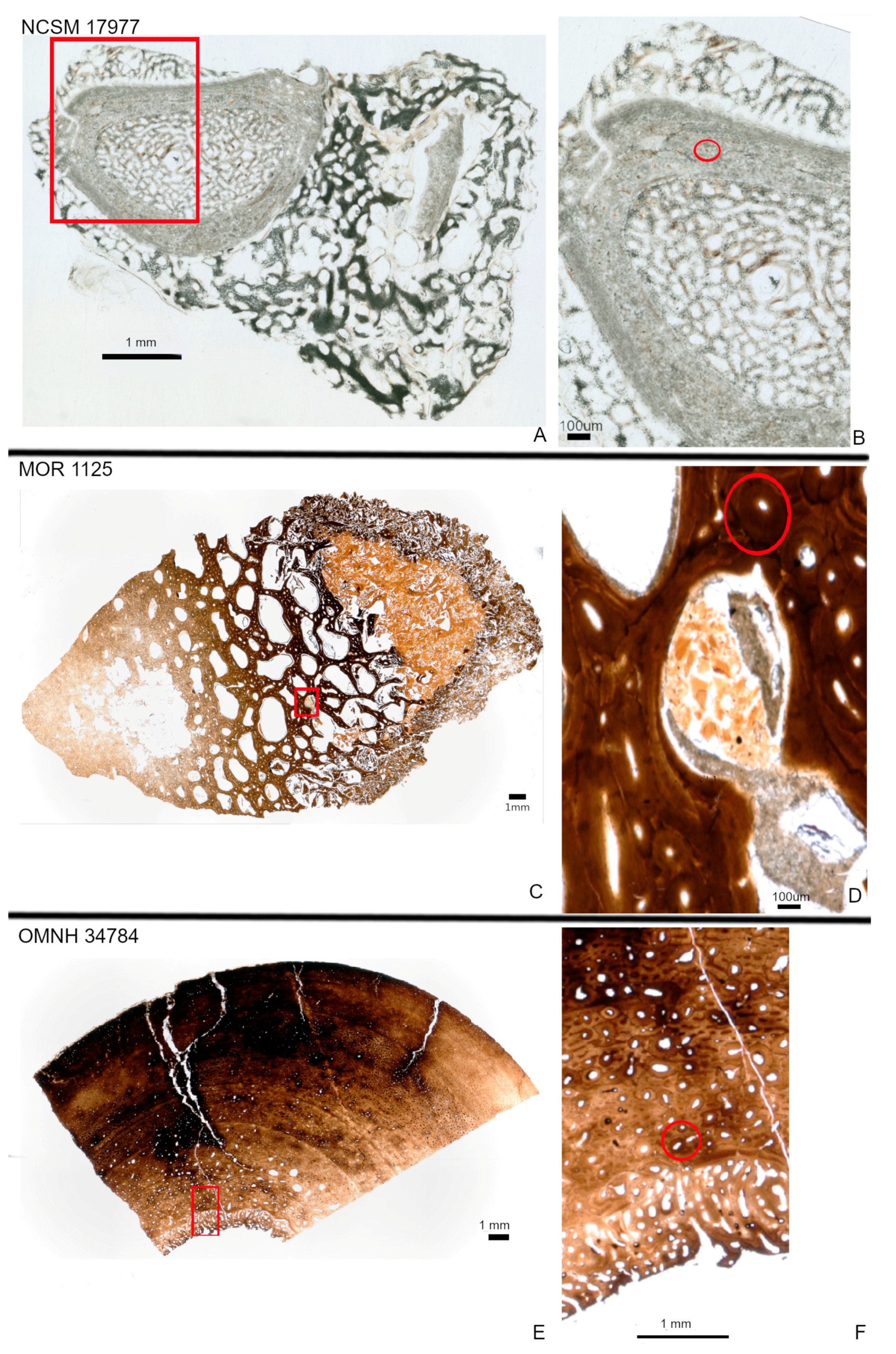
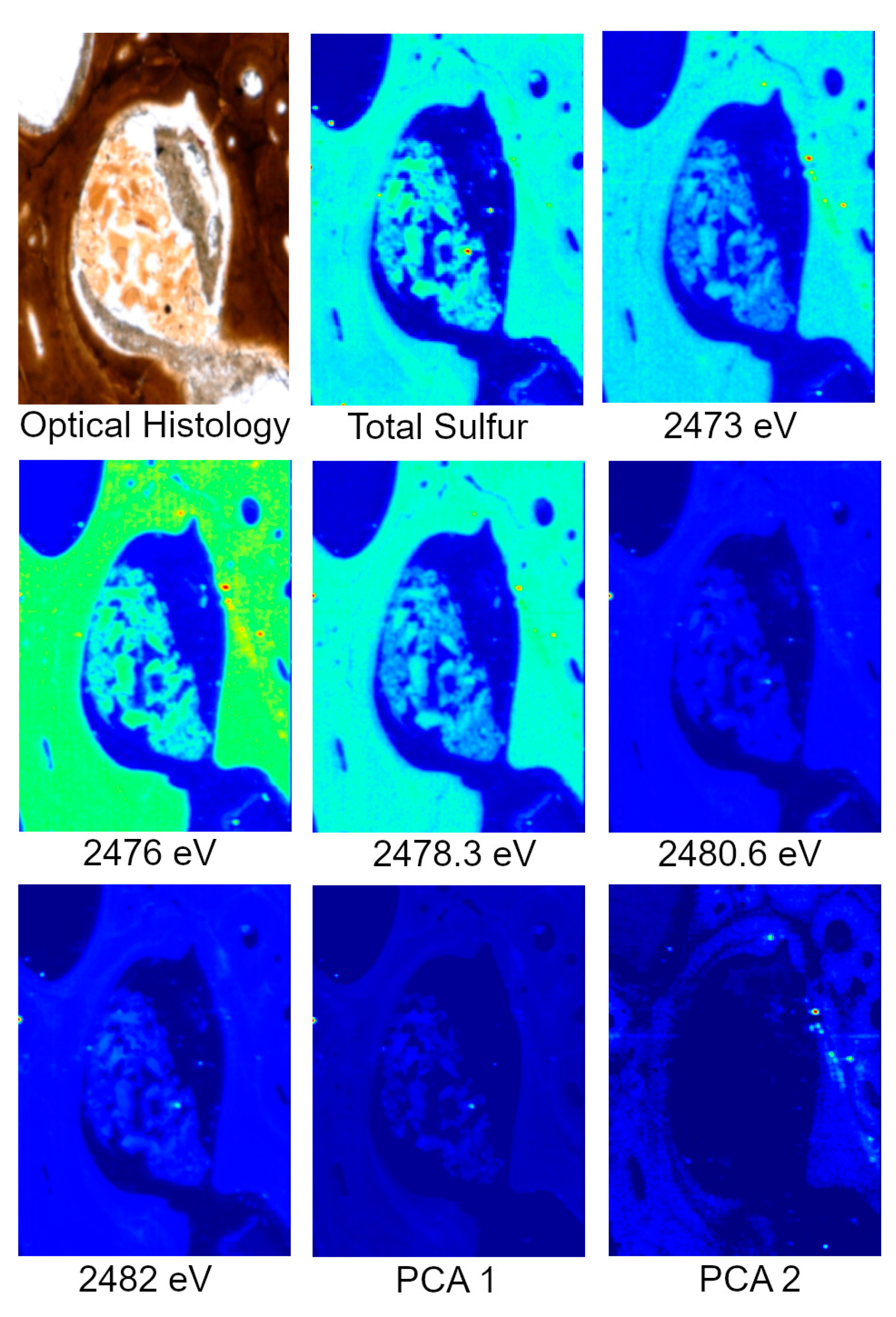
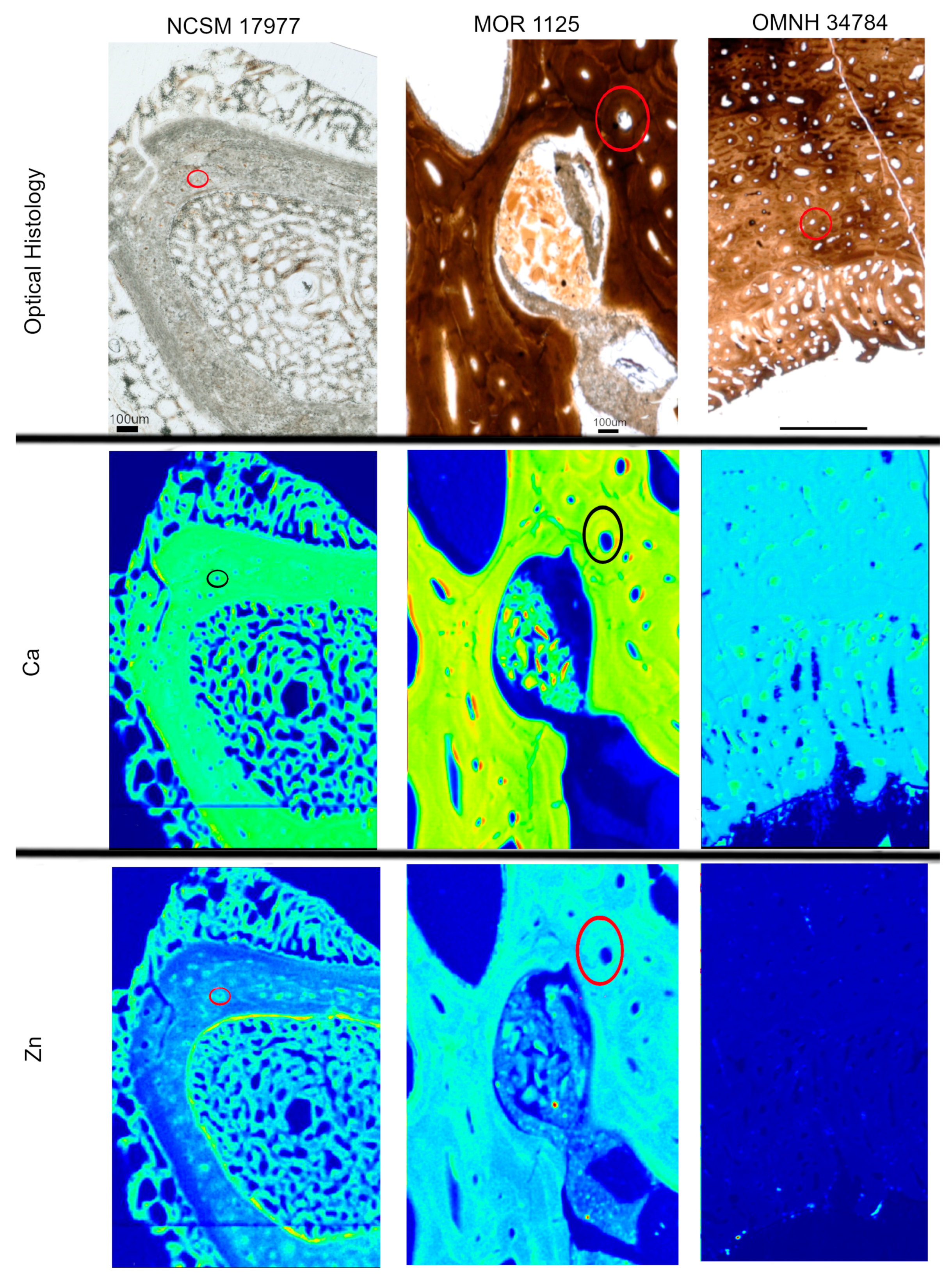
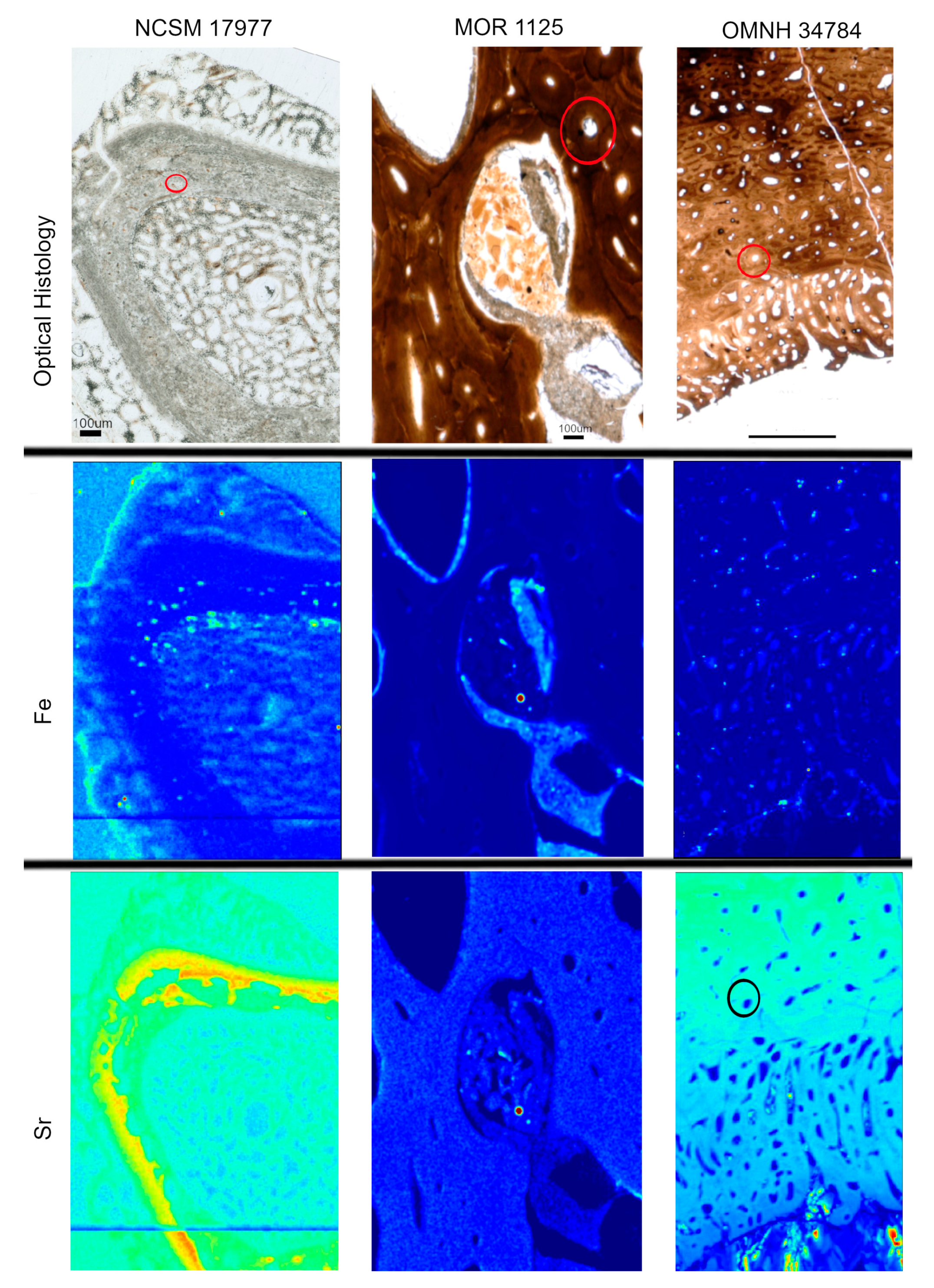
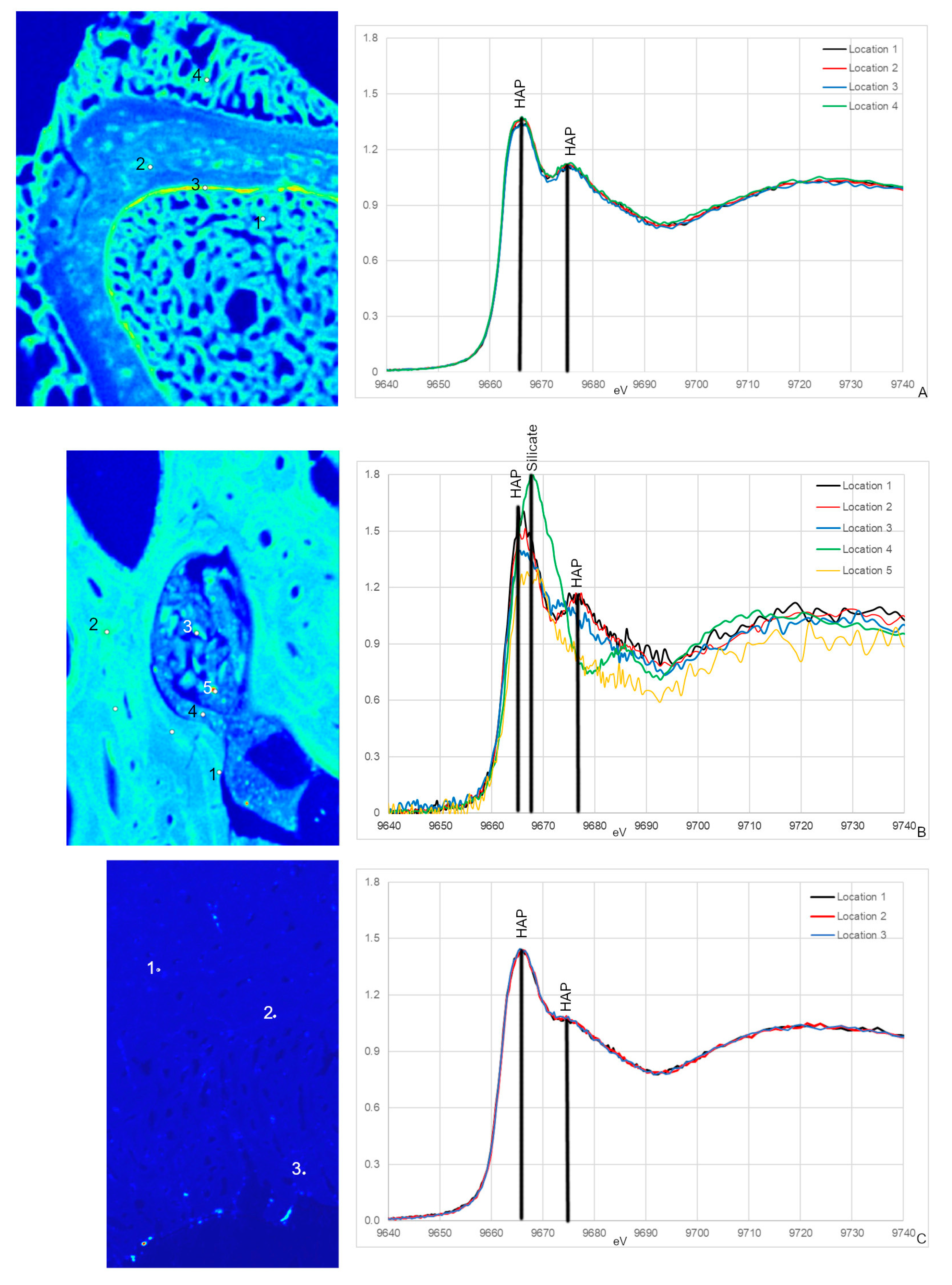
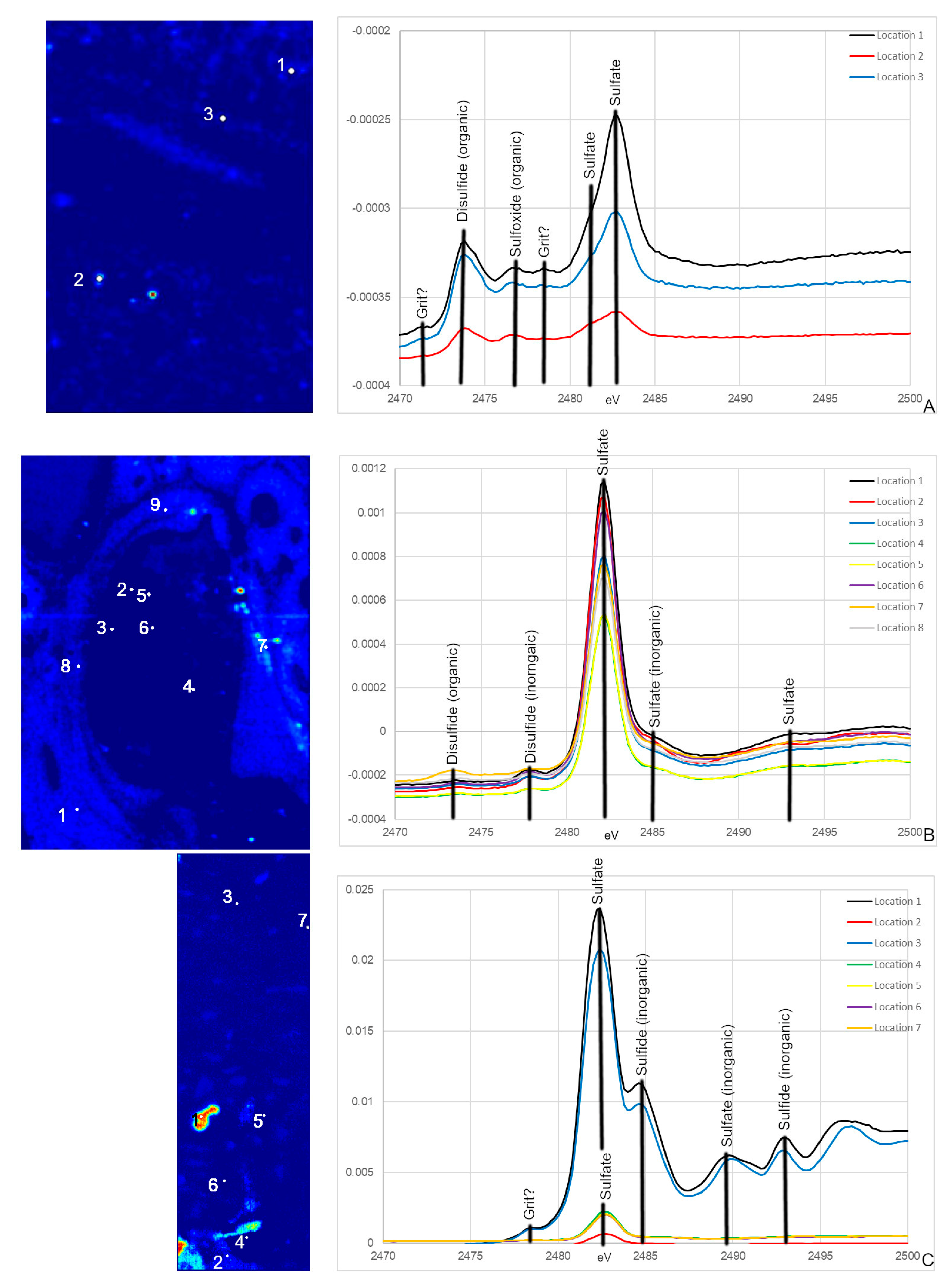
| Analytical Technique | MOR 1125 Tissue Type | Results and Citation |
|---|---|---|
| Transmitted light microscopy (LM) | Demineralized endosteal bone (MB) and cortical bone (CB) | Flexible, collagen-like fibrous matrix, transparent, hollow vessel-like structures, osteocyte-like microstructures with filopodia [24,25] |
| Scanning electron microscopy (SEM) | Demineralized Medullary Bone (MB) and Cortical Bone (CB) | Fibers arranged as bundles, consistent with collagen [24] |
| SEM | Isolated microstructures consistent with osteocytes (hereafter ‘osteocytes’ to conserve space) and microstructures consistent with blood vessels (hereafter vessels) liberated from demineralized CB | Isolated, free-floating 3-D osteocyte morphs, with long, extensive filipodia and intracellular contents, consistent in morphology and location to osteocytes from extant vertebrates; interconnected, hollow, flexible and transparent microstructures consistent with extant vessels [18,23,25] |
| SEM | Biofilm grown in extant deproteinated bone | Patchy distribution after demineralization of bone substrate, unable to maintain shape, differed morphologically from structures observed in MOR 1125; no visible osteocyte structures [14] |
| Atomic force microscopy (AFM) | Demineralized CB and MB | Matrix fibers demonstrating periodicity of ~70 nm consistent with collagen [22] |
| Transmitted electron microscopy (TEM), localized electron diffraction | Ultrathin sections of CB and MB | Mineral phase identified as biogenic hydroxylapatite (HA) [22] |
| Transmitted electron microscopy (TEM), localized electron diffraction | Isolated vessels and osteocyte liberated from CB | Iron intimately associated with vessel walls and osteocyte surfaces. Vessel walls under TEM retain differentiated structures and layers, consistent with extant vessels ([17,18,22,23], Schweitzer et al., in prep) |
| Electron energy loss spectroscopy (EELS) | Vessels and osteocytes liberated from demineralized CB | Iron localized to vascular walls and osteocytes, but not seen in fibrous matrix [17] |
| Micro-X-ray fluorescence mapping of Fe | Vessels liberated from demineralized CB | Confirmation of iron localizing to vessel walls [17] |
| Micro-X-ray Fe XANES | Vessels liberated from demineralized CB | Diagenetic goethite Fe within vessels and vessel walls, also seen in treated extant vessels [17] |
| Immunohistochemistry (IHC), antibodies against chicken collagen I (Col I) and osteocalcin (OC) | Demineralized CB and MB | Localized binding of antibodies to tissue, supporting preservation of Col I and OC epitopes, using multiple controls [23] |
| IHC to actin antibodies | Isolated vessels and osteocytes from demineralized CB | Localized antibody binding in patterns seen in extant homologues. Different binding patterns in each tissue/cell type support endogeneity, along with negative controls [17,18] |
| IHC using antibodies to chicken phosphoendopeptidase (PHEX) | Osteocytes liberated from demineralized CB | PHEX antibodies localized to osteocyte-like structures, but not to matrix. Binding was specific and controls were negative. Antibody specificity was confirmed to be avian specific; no binding was seen to extant crocodile osteocytes, only bird [18] |
| ICH using antibodies to DNA backbone | Osteocytes liberated from demineralized CB | Antibodies localized in a single spot internal to some dinosaur osteocytes. No binding was seen to filopodia or other materials [18] |
| IHC using antibodies to keratan sulfate | Demineralized CB and MB | Binding in a globular pattern in extant and dinosaur MB, no binding in adjacent CB from the same specimens [13] |
| Histochemical localization using DNA intercalating stains propidium iodide (PI) and 4′, 6′-diamidino-2-phenylindole dihydrochloride (DAPI) | Osteocytes liberated from demineralized CB | Binding followed pattern seen with anti-DNA backbone antibodies, specific to internal region of cell, and only a single spot. No staining was observed on filopodia or other structures [18] |
| Histochemical localization using Alcian blue. | Demineralized CB and MB | Differential staining, with MB much more intensely stained than CB, consistent with MB in extant avian bone [13] |
| Histochemical localization with High-Iron Diamine (HID) | Demineralized CB and MB | Differential staining, with MB staining much more intensely relative to CB, consistent with extant avians [13] |
| Time-of-flight secondary ion mass spectrometry (ToF-SIMS) | Demineralized CB and MB | Identification of amino acids glycine (gly) and alanine (ala) support presence of Col I [23] |
| Mass spectrometry (MS) | Demineralized and extracted vessels, matrix and osteocytes | Multiple collagen and actin peptide sequences [18,20,21] |
| Peptide mapping | Peptides recovered from demineralized and extracted bone matrix | Fossil-derived peptides mapped to monomers 2,3, and 4 on extant collagen models [19] |
| Laser ablation- inductively coupled plasma mass spectrometry (LAICP-MS) | Sectioned CB | Average concentration of exogenous elements from diagenesis (e.g., Fe) lower than in other Hell Creek specimens, with only moderate alteration [7] |
Disclaimer/Publisher’s Note: The statements, opinions and data contained in all publications are solely those of the individual author(s) and contributor(s) and not of MDPI and/or the editor(s). MDPI and/or the editor(s) disclaim responsibility for any injury to people or property resulting from any ideas, methods, instructions or products referred to in the content. |
© 2023 by the authors. Licensee MDPI, Basel, Switzerland. This article is an open access article distributed under the terms and conditions of the Creative Commons Attribution (CC BY) license (https://creativecommons.org/licenses/by/4.0/).
Share and Cite
Anné, J.; Canoville, A.; Edwards, N.P.; Schweitzer, M.H.; Zanno, L.E. Independent Evidence for the Preservation of Endogenous Bone Biochemistry in a Specimen of Tyrannosaurus rex. Biology 2023, 12, 264. https://doi.org/10.3390/biology12020264
Anné J, Canoville A, Edwards NP, Schweitzer MH, Zanno LE. Independent Evidence for the Preservation of Endogenous Bone Biochemistry in a Specimen of Tyrannosaurus rex. Biology. 2023; 12(2):264. https://doi.org/10.3390/biology12020264
Chicago/Turabian StyleAnné, Jennifer, Aurore Canoville, Nicholas P. Edwards, Mary H. Schweitzer, and Lindsay E. Zanno. 2023. "Independent Evidence for the Preservation of Endogenous Bone Biochemistry in a Specimen of Tyrannosaurus rex" Biology 12, no. 2: 264. https://doi.org/10.3390/biology12020264
APA StyleAnné, J., Canoville, A., Edwards, N. P., Schweitzer, M. H., & Zanno, L. E. (2023). Independent Evidence for the Preservation of Endogenous Bone Biochemistry in a Specimen of Tyrannosaurus rex. Biology, 12(2), 264. https://doi.org/10.3390/biology12020264








